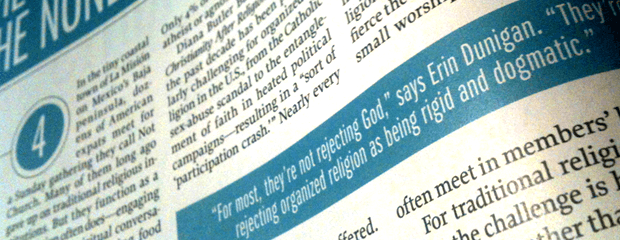A recent article in TIME Magazine (Mar 12) titled, “10 Ideas That Are Changing Your Life,” listed life-changing idea number four as “The Rise of the Nones.” Author Eric Dunigan points out that a growing number of Americans are seeking a relationship with God but are not finding that in church. Is it just me, or is something wrong with that picture? Why do people who want to experience God have to look for him outside the church?
This article highlights part (not all) of what makes our basic approach to church different from many American churches. The reasons are both theologically and demographically driven. Here I want to discuss the demographic component, which is hinted at in “The Rise of the Nones.” The basic question is: how does the way we understand our target group affect our methodology?
The Unchurched Population’s View of Church and Christians
People that don’t go to church are our target audience. We are not primarily trying to reach church people. Church people are already at church. Some of them will join us, and that is great, but our goal is not to move sheep, it’s to reach unchurched people.
Unchurched people are not in church for a reason. In the Bible Belt, at least, it’s not for lack of churches in their area. It’s because of how they perceive the church and the people who profess to be Christians. America is not the same place it was a generation ago. It is increasingly unchristian.
The unchurched population thinks the church is a religious organization with a political agenda. It thinks it is better than everyone else, hates homosexuals, and loves to protest all dissenting points of view. They think we are primarily hypocritical and that our message is irrelevant to their lives, because of how they see it play out in our lives.
They are skeptical of organized religion and churches–and why not? They think these things for a reason. They have seen so many things that are not love. They have seen a lot of hypocrisy. Certainly these are not characteristics of all who claim to be Christians, but the unchurched have seen real things that make them think of us in all of these ways.
This is what’s in many unchurched people’s minds when we talk to them about, or invite them to “church”. They have heard our words, but have also seen our lives, and the latter deems the former irrelevant for them. Why in the world would they want to be a part of something like that? They don’t.
A Different Approach
So how do we approach these people? Words are a must, but words are not enough. They have heard it all before. That’s not the primary problem. They are turned off by what they see. Unchurched people in the Bible Belt need to see the reality of our message played out in our lives–they need to see the love of God in action–and then they will open their hearts to hear what we say. They have seen a lot of things from churches but many have not seen Jesus. That is our understanding of the unchurched world, which is quickly becoming the majority of Americans–the norm outside of our Christian bubbles.
A number of books have been written on this topic: unChristian: What a New Generation Really Thinks about Christianity and Why It Matters, by Dave Kinnamon, and They Like Jesus but Not the Church: Insights from Emerging Generations, by Dan Kimball are two. I have not personally read these books, and am not advocating everything these guys say, but a skim through the table of contents finds them saying what my generation intuitively feels.
We don’t have all the answers of how to reach unchurched people in the Bible Belt, but this understanding of how many of them tend to view the church and Christians shapes our relational and missional mentality towards how we engage them and call them to follow Jesus.

Comments